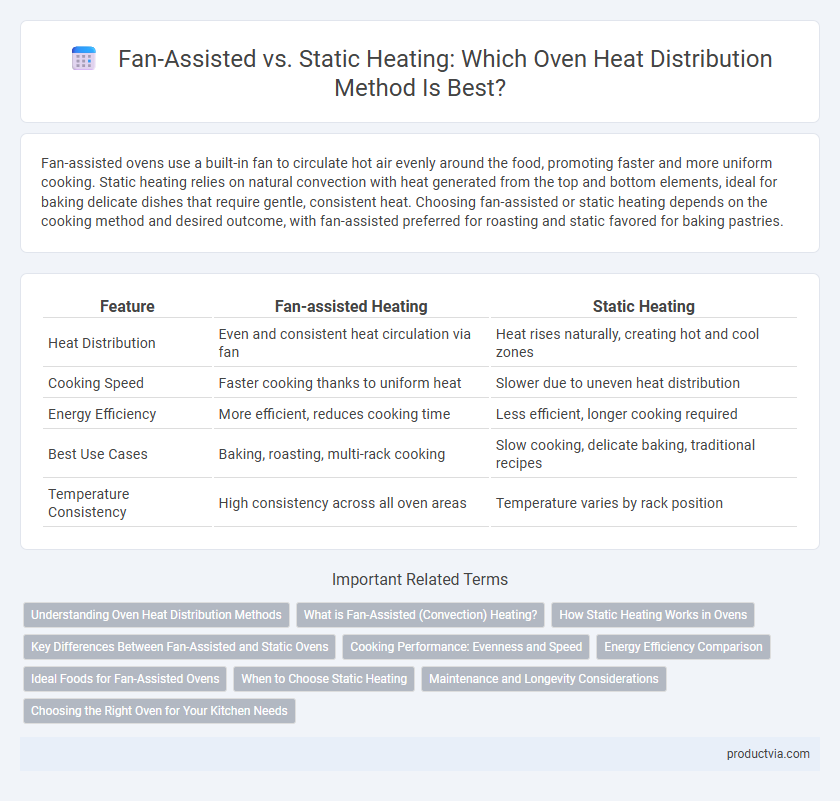Fan-assisted ovens use a built-in fan to circulate hot air evenly around the food, promoting faster and more uniform cooking. Static heating relies on natural convection with heat generated from the top and bottom elements, ideal for baking delicate dishes that require gentle, consistent heat. Choosing fan-assisted or static heating depends on the cooking method and desired outcome, with fan-assisted preferred for roasting and static favored for baking pastries.
Table of Comparison
| Feature | Fan-assisted Heating | Static Heating |
|---|---|---|
| Heat Distribution | Even and consistent heat circulation via fan | Heat rises naturally, creating hot and cool zones |
| Cooking Speed | Faster cooking thanks to uniform heat | Slower due to uneven heat distribution |
| Energy Efficiency | More efficient, reduces cooking time | Less efficient, longer cooking required |
| Best Use Cases | Baking, roasting, multi-rack cooking | Slow cooking, delicate baking, traditional recipes |
| Temperature Consistency | High consistency across all oven areas | Temperature varies by rack position |
Understanding Oven Heat Distribution Methods
Fan-assisted ovens use a built-in fan to circulate hot air evenly throughout the cooking chamber, ensuring uniform heat distribution and reducing cooking times. Static heating ovens rely on natural heat radiation from the top and bottom elements without air circulation, which can result in uneven temperatures and longer cooking durations. Understanding these heat distribution methods helps in selecting the ideal oven type for consistent baking and roasting results.
What is Fan-Assisted (Convection) Heating?
Fan-assisted (convection) heating in ovens utilizes a built-in fan to circulate hot air evenly throughout the cooking chamber, ensuring consistent temperature distribution and faster cooking times. This method minimizes hot spots compared to static heating, where heat radiates from fixed elements without air movement. The improved air circulation in fan-assisted ovens enhances browning and crisping, making it ideal for baking, roasting, and multi-rack cooking.
How Static Heating Works in Ovens
Static heating in ovens uses heating elements located at the top and bottom of the cooking chamber to radiate direct heat onto food, relying on natural convection currents for heat distribution. This method creates a stable temperature environment, ideal for slow cooking and baking where gentle, even heat is required to develop flavors and textures. Unlike fan-assisted ovens, static heating does not circulate air, resulting in less moisture loss and a crispier surface on baked goods.
Key Differences Between Fan-Assisted and Static Ovens
Fan-assisted ovens use a built-in fan to circulate hot air for even heat distribution, resulting in faster and more uniform cooking compared to static ovens. Static ovens rely on natural heat rising from the bottom and top heating elements, creating varied temperature zones ideal for baking delicate items like bread and pastries. The key difference lies in fan-assisted ovens offering consistent temperature control and reduced cooking times, whereas static ovens provide traditional heat that enhances flavor development in certain dishes.
Cooking Performance: Evenness and Speed
Fan-assisted ovens circulate hot air using a built-in fan, promoting faster and more uniform heat distribution that enhances cooking speed and ensures even browning of food. Static heating relies on radiant heat from the oven's top and bottom elements, which can cause hotspots and slower, less consistent cooking performance. For recipes requiring precise temperature control and uniform results, fan-assisted ovens generally deliver superior cooking performance compared to static heating models.
Energy Efficiency Comparison
Fan-assisted ovens use a convection fan to circulate hot air evenly, resulting in faster cooking times and lower energy consumption compared to static heating. Static ovens rely on natural heat radiation from the top and bottom elements, which often leads to uneven cooking and longer operation periods, increasing energy usage. Energy efficiency in fan-assisted ovens can improve by up to 20% due to more uniform heat distribution and reduced cooking times.
Ideal Foods for Fan-Assisted Ovens
Fan-assisted ovens use a convection fan to circulate hot air evenly throughout the oven cavity, ensuring faster and more uniform cooking. Ideal foods for fan-assisted ovens include roasted meats, baked goods like cookies and pastries, and dishes requiring crisp textures such as roasted vegetables and pizzas. This method enhances browning and creates a crispy exterior without drying out the interior, making it perfect for foods needing consistent heat distribution.
When to Choose Static Heating
Static heating in ovens provides consistent, even heat ideal for baking bread and delicate pastries that require gradual, uniform cooking. This method suits recipes where moisture retention is essential, as it prevents air circulation from drying out the food. Choose static heating when precise heat control and gentle cooking are necessary to achieve the best texture and flavor.
Maintenance and Longevity Considerations
Fan-assisted ovens require regular cleaning of the fan and vents to prevent dust buildup that can impede performance, but this maintenance ensures optimal heat distribution longevity. Static ovens have fewer mechanical parts, resulting in lower maintenance needs and generally longer-lasting components, though heat distribution may not be as even. Choosing between fan-assisted and static heating depends on balancing maintenance commitment with desired cooking consistency and oven lifespan.
Choosing the Right Oven for Your Kitchen Needs
Fan-assisted ovens utilize a built-in fan to circulate hot air evenly, ensuring consistent cooking temperatures and faster heat distribution throughout the oven cavity. Static ovens rely on natural heat radiation from the top and bottom elements, creating a more traditional cooking environment ideal for baking bread or delicate pastries requiring slower, gentler heat. Selecting the right oven depends on your cooking style and kitchen needs, with fan-assisted models suited for faster, uniform cooking and static ovens preferred for precision baking.
Fan-assisted vs Static heating for heat distribution Infographic

 productvia.com
productvia.com